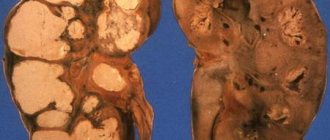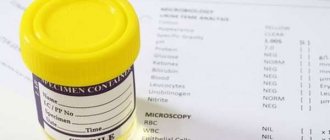Bacteriuria
Even the minimal presence of microorganisms in urine is considered pathological.
The main indicators for detailed studies are:
- number of bacteria per 1 ml of urine;
- genus of microorganisms.
Therefore, regardless of the age group and status of the person (pregnant woman, infant, elderly person, etc.), the presence of any type of bacteria in the urine is a pathology. The main cause is inflammatory diseases of the kidneys or urinary tract (ureters, bladder, urethra).
In children, especially young children, bacteriuria most often occurs due to inflammation of the bladder. It is not difficult for a child to get a cold in the bladder, especially for little girls: just wet your feet while walking or run barefoot on the cold floor. Lack of proper hygiene affects the results of a general urine test, so it is strongly recommended that you wash your child thoroughly before collecting the test.
Women much more often than men suffer from inflammatory diseases of the bladder and urethra due to the relatively short urethral canal, in which bacteriuria is observed.
An infection in women, entering the urethra, quickly rises higher, into the bladder, where all the favorable conditions for the development of pathogenic microflora are present.
In addition, statistically every second woman is familiar with the symptoms of cystitis (acute or chronic):
- frequent acute (unbearable) urge to urinate;
- nagging pain in the lower abdomen and external genitalia (labia majora, clitoris);
- nagging pain in the lower back;
- severe burning sensation when relieving minor needs;
- change in the color of urine: the appearance of pronounced sediment, turbidity (actually bacteriuria), the presence of mucus and blood (hematuria).
It is important to understand that when collecting urine for laboratory testing, certain hygiene rules must be followed. Bacteria and various microorganisms cover the human body; the internal microflora of the vagina contains several types of microorganisms. In addition, microorganisms from the intestines (through the anus and fecal matter) can enter the urine collected for analysis. Therefore, washing (with soap or other intimate hygiene products) is an integral part of a urine test.
Chronic pyelonephritis can cause asymptomatic bacteriuria. The clinical picture is completely absent: the person does not complain of pain when urinating, or pain in the lower back (in the kidney area), or urinary retention. But laboratory tests reveal the presence of various types of microorganisms. Chronic pyelonephritis occurs relatively often in pregnant women, especially if the pregnancy was unplanned (the woman did not undergo a comprehensive examination before conception).
Principles of treating bacteria in urine during pregnancy
Not every bacteriuria needs to be treated. Almost all antibiotics are contraindicated for pregnant women, so a full examination is first performed. If bacteria are found in urine during pregnancy once, a second analysis is performed. If they are found again, they are guided by the clinical picture.
Asymptomatic bacteriuria does not require antibiotic treatment. The attending physician recommends adjusting the diet, eliminating fatty foods, canned food, and marinades. Drinking clean water instead of coffee and tea is beneficial. The optimal amount of fluid consumed is one and a half liters per day.
Herbal decoctions are shown - cranberries, lingonberry and bearberry leaves, chamomile flowers. They have a mild diuretic effect and flush out infection from the urinary tract. It is recommended to wash yourself with herbal decoctions in the morning and evening, and do sitz baths.
For true bacteriuria, antibiotics are indicated. The only drug that is not dangerous for pregnant women is josamycin. It is prescribed as a course for five days, then the analysis is repeated. Additionally, herbal uroseptics with a diuretic effect are recommended. Self-medication is unacceptable; if you have any health complaints, you should consult a doctor.
Causes and pathogenesis
Bacteria can enter urine for a number of reasons:
- Direct inflammatory disease of the kidneys or urethra (primary or secondary);
- Diseases of the intestines or rectum (constipation, hemorrhoids);
- Inflammatory infectious diseases of the female reproductive system (ovaries, uterus, vagina);
- Inflammation of the prostate gland (in men).
Bacteriuria is characteristic of inflammatory processes of the kidneys. Pyelonephritis, especially chronic, can be asymptomatic, but pathogenic microflora is detected during a general urine test. The path of bacteria entering the urine is obvious: the lesion is localized in the kidney, less often in both.
Inflammation of the ureter develops relatively rarely. May be caused by obstruction (blockage) of the urinary duct or pelvis, which leads to stagnation of urine. Stagnation of urine makes itself felt by a sharp nagging pain in the lumbar region, so most often people seek medical help on their own.
Inflammatory processes in the bladder are accompanied by a sharp, pronounced nagging pain. Pathogenic microorganisms develop in the cavity of the bladder, which provokes bacteriuria at the outlet (initially, urine descending from the kidneys does not have bacteriological impurities).
Infectious diseases, accompanied by inflammation and bacteriological damage, can be localized in the urethra. Urethritis is often caused by sexually transmitted diseases - chlamydia, gonorrhea, and less often - syphilis.
In men, urethritis may appear as redness of the outer edges of the urethra. In this condition, not only microorganisms are detected in the urine, but also impurities of blood, blood, and protein. Urethritis caused by gonorrhea or chlamydia may not appear in women before pregnancy, but makes itself felt at 3-5 months of pregnancy. The same applies to children in the first year of life: when passing through the birth canal, the baby “catches” harmful microorganisms, which leads to the development of the disease. The first symptoms may appear only at 2-4 months of life.
The walls of the lower intestines border the urethra and the walls of the vagina (in women). Therefore, chronic constipation (including those occurring during pregnancy), inflammation of the hemorrhoids (hemorrhoids), inflammation of the prostate gland (in men) can provoke the penetration of bacteria from the intestines into the cavity of the bladder and urethra. But most often, bacteriuria appears due to improper hygiene of the genital organs: along with the contents of the intestines or vagina, microorganisms enter the surface of the urethral canal (urethra), from where they seep into the urethra itself, and then upward, affecting the bladder, ureters and even the kidneys.
Ways bacteria get into urine
Asymptomatic bacteriuria during pregnancy
Asymptomatic bacteriuria is detected only by the results of a urine test; it does not report itself with any other manifestations. Expectant mothers feel great and are not even aware of the impending threat. This is why it is so important for pregnant women to undergo all necessary tests in a timely manner.
According to various sources, the state of asymptomatic bacteriuria is found in 6 to 11% of pregnant women; this largely depends on the socio-economic status, concomitant pathologies and health status. Often, bacteriuria can precede pregnancy, simply not being detected earlier; sometimes bacteriuria is detected for the first time during pregnancy. In many pregnant women with bacteriuria, in about a third of cases, signs of chronic pyelonephritis are found; vesicoureteral reflux, dilated ureters or kidney stones may be detected.
Kinds
There are several main classifications of bacteriuria:
- According to the presence of symptoms: true and false (asymptomatic).
- According to the distribution of the root cause: ascending and descending
- By pathogen: staphylococcal, colibacillary, streptococcal, gonococcal.
The truth or falsehood of bacteriuria is determined during further examination, after the initial detection of bacteria in the urine. True is the form in which the proliferation of microorganisms occurs directly in the organs of the urinary system.
False or asymptomatic bacteriuria is characteristic of concomitant diseases and conditions, such as:
- constipation;
- haemorrhoids;
- vaginitis
Ascending and descending bacteriuria is also determined after identifying a focus of inflammation. The ascending appearance is characteristic of a focus of infection located in the urethra or bladder - in this case, the bacteria seem to rise up the urethra and can cause inflammation of the kidneys.
Descending bacteriuria is a characteristic manifestation of pyelonephritis and ureteral obstruction, when the source of inflammation is located in the upper parts of the urinary system.
The type of microorganisms present in the urine is identified using bacterial culture. Staphylococci belong to the opportunistic microflora: millions of different staphylococci live on human skin and are capable of causing inflammation and bacteriuria only when the immune system is weakened. Colibacillary bacteriuria is characterized by the presence of Escherichia coli in the urine. Such infection can occur due to pathological processes in the intestines and non-compliance with personal hygiene rules. Streptococci are often found in the urine of people who have had diseases corresponding to the causative agent:
- sore throat;
- pneumonia;
- streptococcal bronchitis;
- scarlet fever;
- periodontitis;
- otitis.
In this case, the penetration of streptococci into the urine is due to a sharp decrease in the activity of the immune system. It is also possible for a child to become infected during childbirth or during sexual intercourse.
Gonococci are the messengers of gonorrhea (a sexually transmitted disease). Therefore, those who have even a small amount of gonococci in their urine are recommended to visit a venereologist and undergo the appropriate tests. In the video about asymptomatic bacteriuria in pregnant women:
Methods for testing for bacteria in urine
There are several ways to find bacteria in urine:
- express test - use a litmus strip, which changes color under the influence of nitrites secreted by microbial cells;
- bacteriological seeding - biological fluid is applied to a nutrient medium, placed in a thermostat and it is determined which microorganisms have grown and their number.
Using bacterial culture, you can find out which antibiotics microorganisms are sensitive to. This is used when prescribing treatment.
Additional examination methods are prescribed to establish a diagnosis - general clinical blood tests, vaginal smear, ultrasound of the kidneys.
Symptoms
The symptoms of bacteriuria can be very diverse - from asymptomatic to acute pain. Bacteriuria is not an independent disease, but a clinical symptom of a number of pathological processes, often inflammatory, occurring in the body.
You can independently identify bacteriuria by observing the color of your own urine. If the urine is cloudy, has an unpleasant odor (from sour to the smell of rotten vegetables), has sediment in the form of flakes or mucus, then this is most likely how bacteriuria manifests itself.
Treatment
The doctor chooses the treatment tactics after examining the patient. Pyuria is only a symptom. Therefore, the underlying disease should be treated.
After the inflammatory process has stopped, the urinalysis parameters return to normal. Treatment is carried out both on an outpatient basis and in a hospital.
The treatment plan includes:
- Antibiotics – to suppress pathogenic flora. The drugs of choice are fluoroquinolones and cephalosporins. If they are ineffective, the course of treatment is adjusted taking into account the results of urine culture.
- Plant-based uroseptics, herbal decoctions, urine alkalizers.
- Drugs that improve urine flow and help normalize the size of the prostate gland.
- Glucocorticosteroids – for the autoimmune nature of the disease.
- Immunomodulators, vitamins.
- Surgery – removal of the appendix, lithotripsy, nephrectomy. In case of chronic renal failure, organ transplantation is indicated.
If the inflammatory process develops after catheterization, then the course of taking antibiotics and uroseptics lasts from 5 to 7 days.
For pyelonephritis, urolithiasis, prostatitis, the duration of therapy is calculated individually. Usually 7-10 days are enough. During this time, urine test results return to normal.
But if treatment is stopped prematurely, the disease can become chronic.
If pyuria is caused by inflammation of the appendix, tumor, dropsy or necrosis of the kidney, obstruction of the ureter, or transplant rejection, then surgical treatment is indicated. Bed rest is prescribed only for severe cases of the disease.
Diet is an essential element of therapy. Spicy, fatty foods are excluded from the diet. It is recommended to eat soups, milk porridges, stewed vegetables and fruits. Heat treatment - boiling, baking, stewing.
Marinades and pickles are prohibited, as they irritate the organs of the urinary system and contribute to fluid retention in the body.
Alcoholic drinks should be excluded. Ethanol increases diuresis, increasing the load on the kidneys. In addition, it is incompatible with antibiotics and other drugs.
Be sure to drink enough fluid. This helps remove metabolic products and waste from pathogenic flora from the body.
Diagnostics
The norm is indicative - the absence of bacteria and other impurities. The presence of microorganisms is considered a pathology. In case of bacteriuria, to confirm the results, urine collection and analysis is repeated, before which the patient is advised to wash thoroughly. In a hospital setting, washing can be carried out by a nurse or orderly. It is preferable to use a sterile container to collect the material, but for general urine analysis, a clean, dry container is often used.
Rules for collecting urine for general analysis:
- Wash thoroughly with warm water and soap or other intimate hygiene products.
- An average portion of urine is collected.
- Touching the edges of the container (container) must be prevented.
- Women should not donate material during menstruation, but if there is an urgent need, a tampon must be inserted into the vagina and then washed again. In addition, the use of a tampon is also recommended for women without menstruation (during pregnancy and after menopause) to avoid vaginal discharge from getting into the collected material. Men need to expose the head of the penis by retracting the foreskin.
It is important to deliver the urine to the laboratory within an hour after collection. If kept in a room at room temperature for a long time, urine can change its physicochemical properties, leading to false results.
For bacterial culture, it is necessary to collect urine in a sterile container, observing the above conditions. The analysis is carried out within 3-7 days by placing the material in a container (Petri dish) with a nutrient medium. Not only the presence of microorganisms is determined, but also their variety and sensitivity to various groups of antibiotics.
Reasons for the appearance of bacteria and mucus in urine analysis
Mucus in a general urine test is a natural secretion of the mucous membrane of the epithelium. It is constantly produced by the urinary tract (especially in women). During the period of urine collection for analysis, mucus penetrates with vaginal discharge, therefore, when examining urine in women, mucus in a general urine test is very often found in small quantities.
An important factor when collecting urine for analysis is the cleanliness of the urine container, since often insufficient disinfection of the container is the reason for the detection of bacteria in a urine test. To collect urine for analysis, it is necessary to maintain genital hygiene. It is better to use a clean container for urine, dry and sterile, which is sold in pharmacies.
The amount of mucus in the urine increases with the inflammatory process occurring in the lower parts of the urinary tract. Therefore, the presence of mucus in a general urinalysis indicates the presence of epithelial tissue in the urine. This is preceded by an inflammatory process of the urinary system, as well as long-term stagnation of urine in the body (leads to a large amount of mucus and complicates drainage). Thus, a certain amount of mucus is excreted from the body through urine.
The urinary system is caused by systemic (general) and local causes. General diseases that do not occur from local infections are systemic causes. Local causes include infections that enter the urethra from the outside (for example, sexually transmitted diseases).
As a rule, mucus and bacteria are detected in a urine test due to a violation of well-known rules when collecting urine for analysis. If a large amount of mucus is detected, the analysis is often carried out again. If mucus is repeatedly detected in a urine test, the person is sent for diagnosis of the disease.
It is important to remember that the detection of mucus or bacteria in a urine test is not always a pathology, so in such cases the urine test should be repeated, observing all the rules. However, women may be concerned if a large amount of mucus is detected in a urine test
This indicates that the normal functioning of the genitourinary system is disrupted. Mucus in urine analysis is a sign of congestion of the bladder, kidneys, or chronic inflammatory diseases (cystitis, urethritis, pyelonephritis, nephropathy, urolithiasis or kidney stones)
However, women may be concerned if a large amount of mucus is detected in a urine test. This indicates that the normal functioning of the genitourinary system is disrupted. Mucus in a urine test is a sign of congestion in the bladder, kidneys, or chronic inflammatory diseases (cystitis, urethritis, pyelonephritis, nephropathy, urolithiasis or kidney stones).
Typically, urine found in the bladder is sterile. But when urination occurs, bacteria and mucus enter the urine from the lower urethra. The normal amount of bacteria in a urine test should not exceed 10,000 in 1 ml.
The detection of bacteria in urine analysis (with a qualitative method - more than one bacterium, with a quantitative method - more than 100,000 bacteria per 1 ml) is called bacteriuria.
Asymptomatic bacteriuria is the presence of bacteria in a urine test in the absence of patient complaints. This condition can be observed due to organic changes in the urinary tract, in women who have an unsystematic sexual life, in older people.
It is important to remember that the occurrence of asymptomatic bacteriuria increases the risk of developing infections, especially during pregnancy (infections occur in approximately 40% of cases). In such cases, the presence of bacteriuria and the type of bacteria can only be determined by bacteriological examination.
Forms
True bacteriuria and false bacteriuria
True bacteriuria is bacteria that not only enter the urinary tract, but also multiply there, causing severe inflammation. False bacteriuria - bacteria penetrate the bladder and urinary tract, but do not have time to spread and multiply due to the fact that the person either has an active immune system or is taking antibacterial therapy for an inflammatory disease.
If bacteria accept urine as a nutrient medium, where there are slightly alkaline and neutral conditions necessary for them, they begin to multiply, sometimes their number exceeds 100,000 in one milliliter of urine. True bacteriuria or significant bacteriuria, as it was called back in the middle of the last century by microbiologists Kass and his colleague Finland, is indisputable evidence for the diagnosis of urinary tract infection. Despite the fact that signs of inflammation in the bladder may appear earlier at much lower levels, the Kass and Finland parameter is the only statistically confirmed one and is used in laboratory practice in our time as the main criterion.
Treatment methods
Treatment of bacteriuria in pregnant women should be quite effective and safe for the fetus. However, before starting treatment for this disease, you should verify its accuracy by analyzing urine according to Nechiporenko. If there is an increased content of leukocytes in the urine, a treatment plan is created. Using a urine culture tank, the microorganism that causes the infection is isolated.
The first step in treating bacteriuria is to reduce the acidity and amount of urine. Drugs such as Canephron, Cyston, and kidney teas are used. After a course of these medications, usually 3-7 days, a repeat urine culture is done. If urine contamination decreases below 100,000 microorganisms per 1 ml, bacteriuria is considered cured.
The second step in treating bacteriuria is taking antimicrobial drugs. Their appointment is possible only after the 1st trimester, when the fetal organs are completely congested. Typically, penicillins and cephalosporins are used in the treatment of bacteriuria; the duration of their use is 5-7 days. Next, a control urine test is performed. If bacteriuria does not disappear, stronger antibiotics, such as fluoroquinolones, are prescribed.
Thus, the duration of therapy for bacteriuria is on average 1-2 weeks. For mild cases of the disease, outpatient treatment with routine examinations by the attending physician is possible. If bacteriuria is caused by serious infectious processes in the kidneys and urinary tract, urgent hospitalization is necessary.
Diagnosis of bacteriuria
Bacteriuria in urine is determined by collecting fresh urine; as a rule, the middle portion is collected. A urine test for bacteriuria is carried out after following all hygiene procedures in order to avoid distortion of the results obtained, this is especially important for female patients. The speed of research is also important, that is, from the moment the material is collected until it reaches the laboratory directly, this is necessary to reduce the risk of flora reproduction in warm conditions with access to air. Of course, the most “pure” in this sense are tests collected by catheterization or aspiration, but these methods can also provoke bacteriuria, so they are used only in exceptional cases, according to strict indications, for example, when the patient is immobile or atony of the bladder.
A urine test for bacteriuria can be performed in several ways.
Bacteriuria in urine is detected either during routine clinical examinations, or during an already developed inflammatory process. Depending on the purpose and urgency of diagnosis, either highly sensitive methods, such as urine culture for bacteriuria, which require a lot of time to process the results, or fast, but not entirely accurate methods by which bacteriuria is determined in urine, can be used.
Approximate chemical methods are used as an express method:
- TTX test or method for the reduction of triphenyltetrazolium chloride, which uses the property of bacteria to convert the color of colorless tetrazolium salts to blue (formazan derivative).
- The Griess test is a nitrite method, when nitrates, when interacting with present bacteria, are transformed into nitrites. Nitrites, in turn, are detected using special Griess reagents. The test is suitable for material (urine) of adults, since urine in children usually does not contain nitrates.
- Glucose reduction test, when the ability of microorganisms to reduce glucose in small quantities is used. A reagent (paper strip) is dipped into the morning urine sample, which indicates the presence or absence of glucose. If there is no certain amount of glucose, this means that bacteria have “absorbed” it. The test is not 100% informative, but as an express method it is considered acceptable at the initial diagnostic stage.
Urine culture for bacteriuria
The most informative is urine culture for bacteriuria, when the number of reproducing bacteria within certain normal limits is calculated. This method is considered the most sensitive, especially for determining the degree of bacterial colonization, but requires 24 to 48 hours to complete. The Gould method is less time consuming and more simplified. Sowing urine for bacteriuria according to Gould is a method when the material is sown on agar, in a special Petri dish, in 4 sectors. Each time, urine is transferred to the next sector using a sterile platinum loop. To determine the degree of bacteriuria, you only need 24 hours; this time is enough to incubate bacteria at a comfortable temperature for them - 37 degrees. Next, the number of bacteria is calculated using a special table. Also among faster sowings is a method in which plates coated with a nutrient medium are immersed in urine. After immersion in urine, the plates are quickly transferred to special containers, where the bacteria are incubated at a warm temperature for 12-16 hours. The degree of bacteriuria is determined by comparing the results with the normal scale. This is the most accurate test, the reliability of which is within 95%.
It is advisable to carry out any analysis for bacteriuria twice, since even with false bacteriuria, the second culture can show a significant increase in the number of bacteria. This is explained by the fact that the first study may have been carried out with material that was collected during heavy drinking or dysuria; distortion is also possible when taking antibiotics or antiseptic drugs. In addition, bacteriuria in urine, with a properly selected research method, makes it possible to identify the true pathogen, determine its sensitivity to medications and select adequate treatment.
[54], [55], [56], [57], [58], [59], [60]
Symptoms of bacteriuria
Bacteriuria demonstrates symptoms in accordance with the underlying disease. Bacteriuria occurs (diagnosed) most often with pyelonephritis, urethritis and cystitis.
Bacteriuria can also be a symptom of the following pathologies:
- Prostate adenoma.
- Prostatitis, both chronic and in the acute stage.
- Diabetes.
- Bacterial sepsis.
- Urethritis.
Bacteriuria exhibits symptoms characteristic of pyelonephritis, urethritis and cystitis; other diseases do not have specific symptoms, which make it possible to differentiate the nosology only by laboratory analysis of urine.
Bacteriuria, symptoms similar to those of pyelonephritis:
- Dysuria – frequent or slow urination, burning, pain.
- Spontaneous release of urine.
- Transient nausea, sudden urge to vomit.
- Sharply rising body temperature, chills.
- Low-grade fever for 1-2 weeks.
- Pain in the lumbar region.
- Pain in the lower abdomen, in the bladder area.
- Cloudy urine, often interspersed with pus, with an unpleasant odor uncharacteristic of urine.
Bacteriuria, symptoms similar to those of urethritis:
- Discharge from the urethra, often with pus.
- Painful urination, dysuria.
- Hyperemic edges of the urethra, irritation, burning.
- Pain in the perineum.
- Increased body temperature, chills.
- General deterioration of condition, weakness.
Bacteriuria, symptoms identical to those of cystitis:
- Dysuria is frequent, painful urination.
- Burning during urination.
- Frequent urge to urinate with little urine output.
- Uncharacteristic odor of urine.
- Cloudy urine, change in color.
- Chronic aching pain in the lower abdomen.
- Possible increase in body temperature.
- Discharge from the urethra, often with pus.
[41], [42], [43], [44], [45]











